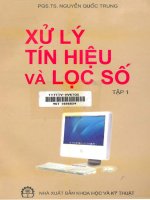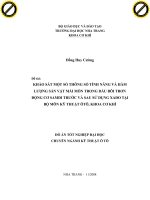Thiết kế, chế tạo hệ tách xung nơtron và gamma sử dụng kỹ thuật xử lý tín hiệu số tt tiếng anh
Bạn đang xem bản rút gọn của tài liệu. Xem và tải ngay bản đầy đủ của tài liệu tại đây (418.84 KB, 2 trang )
ABSTRACT
The organic scintillator detector has been used in neutron detection
systems with advantage of high efficiency, but they are also very sensitive to
gamma. Therefore, gamma events must be identified in these radiation
measurement systems to eliminate. Various algorithms of neutron/gamma
pulse shape discrimination (PSD) have been developed by many radiation
laboratories in order to identify neutron/gamma events from the detector
outputs. The PSD algorithms have achieved good results in the high energy
region (> 200keVee) but that still limited in the low energy region (<
200keVee). Actually, some complex PSD algorithms have been well able to
distinguish between neutron and gamma pulses but these algorithms require
very large hardware resources, and therefore are hardly applied for the
radiation measurement systems in real-time.
The goal of the present thesis is to study various PSD algorithms and to
develop an algorithm that offers highly effective discrimination in the lowenergy region, simple design, and low-cost. The developed PSD algorithm can
therefore be effortlessly applied to neutron measurement systems using
organic scintillator detectors.
Four PSD methods, namely the threshold crossing time, pulse gradient
analysis, digital charge integration, and correlation pattern recognition, have
been studied; a new method has been developed based on calculations with the
reference pulses (RP). These methods have been applied to a homemade
neutron spectroscopy, which is constructed by using a handcrafted organic
scintillator detector, the field-programmable gate array, and the digital signal
processing technique. The used hardware was a DRS4 Evaluation Board, which
is compact, stable, and reliable. Our obtained neutron spectroscopy is not only
accurate but also can simultaneously measure neutron and gamma spectra;
thus it shows good potentials for applying to radiation dosimeters, as well as
warning/safety monitors.
Among all the concerned PSD methods, our newly developed method,
which is based on calculations with the RP, has the best quality: its Figure-ofMerits (FoMs) achieved 7.3 ± 0.2 in the energy region below 200keVee and 8.2
± 0.48 in the energy region from 100 to 1600keVee, and its correct recognition
rate measured on gamma-ray sources reaches 97.2% and 99% without and
with eliminating pile-pulse, respectively.
Briefly, the present thesis provides important information for the
development of PSD algorithms used for organic scintillator detectors. In
particular, a new PSD algorithm that has better quality than all the current
popular algorithms has been proposed. Besides, the present work also makes a
crucial step forward to the domestically fabrication of high-quality and lowcost neutron/gamma spectroscopies in Vietnam.
Keywords: Neutron/gamma pulse separation, neutron detector, pulse shape
discrimination, digital neutron detection system.









